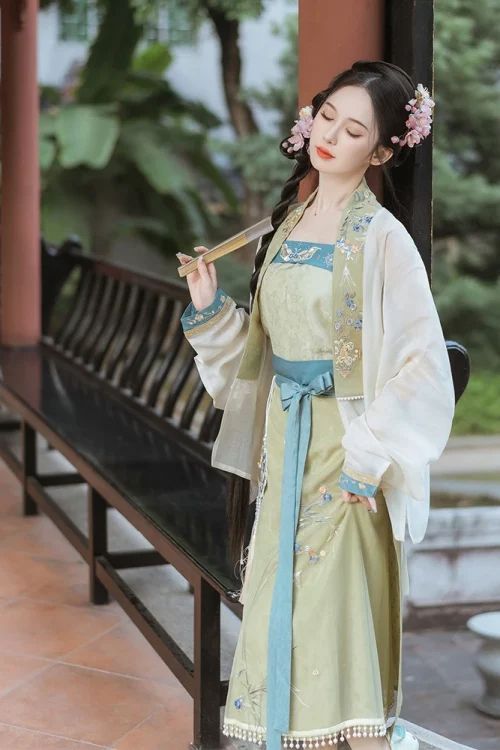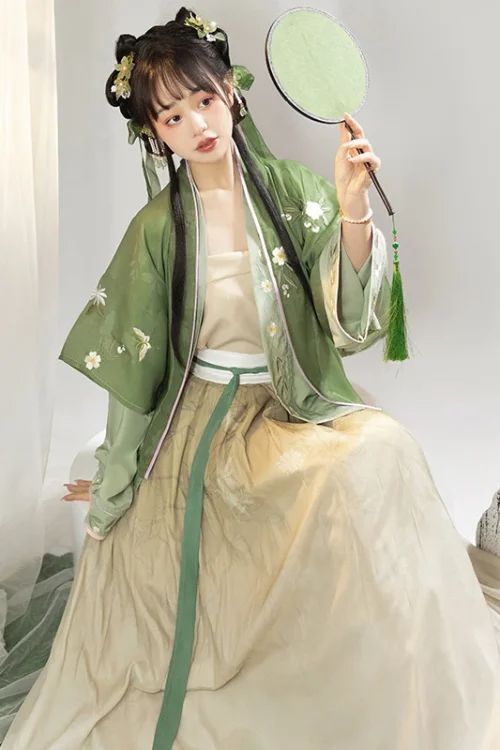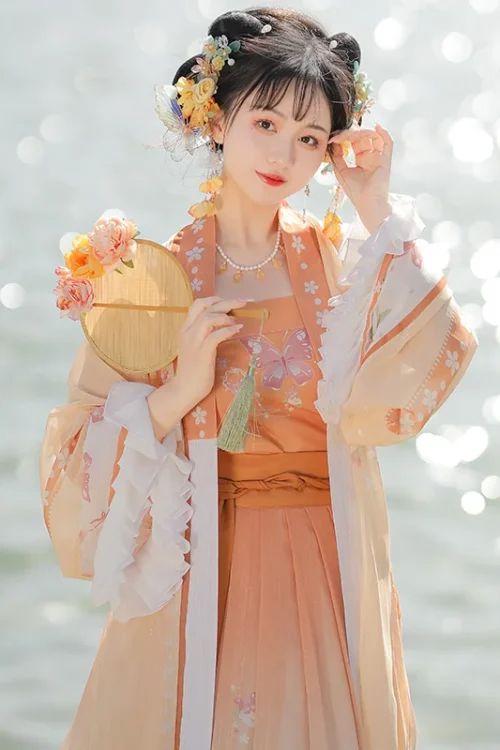The Evolution of Song Dynasty Hanfu Fabrics: From Silk to Cotton
During the Song Dynasty (960-1279), Hanfu, the traditional Chinese clothing, underwent a significant evolution in terms of fabrics and colors. Silk, the luxurious fabric of choice for centuries, continued to be highly prized, but cotton emerged as a more accessible and versatile alternative.

The Dominance of Silk
Silk, renowned for its lustrous sheen and drape, remained the fabric of choice for formal occasions and garments worn by the elite. Its smooth texture and luxurious appearance made it a symbol of status and refinement.
The Rise of Cotton
However, the Song Dynasty witnessed a surge in the production and use of cotton. Cotton, with its breathability and comfort, became increasingly popular for everyday wear and garments worn by the common people. This shift reflected the changing social dynamics and needs of the population.
Symbolic Use of Colors
The colors used in Song Dynasty Hanfu were equally diverse and symbolic. Red, the color of fire and passion, was reserved for auspicious occasions and garments worn by the emperor and his court. Yellow, representing royalty, was highly valued and used in imperial garments.
- Green: Associated with nature and prosperity, widely used for both men and women.
- Blue: Symbolizing tranquility and harmony, often chosen for more casual wear.
- Purple: A rare and expensive dye, reserved for the highest ranks of society.
Patterns and Designs
In addition to solid colors, Song Dynasty Hanfu often featured intricate patterns and designs inspired by nature, such as flowers, birds, and animals. These patterns reflected the artistic sensibilities of the time, influenced by Buddhist and Taoist motifs.
Aesthetic and Practical Balance
The combination of fabrics and colors in Song Dynasty Hanfu created a subtle and sophisticated aesthetic. Silk garments with vibrant colors and intricate patterns exuded elegance, while cotton garments with more muted colors conveyed comfort and practicality.
Conclusion
The evolution of Song Dynasty Hanfu fabrics and colors not only reflected the changing social and economic conditions of the time but also showcased the artistry and creativity of ancient Chinese textile artisans. These fabrics and colors continue to inspire contemporary fashion designers and textile enthusiasts, serving as a testament to the enduring legacy of Chinese textile art.
The Symbolic Significance of Song Dynasty Hanfu Colors
During the Song Dynasty (960-1279), Hanfu, the traditional Chinese clothing, reached its zenith of elegance and sophistication. The fabrics and colors employed in Song Dynasty Hanfu were not merely aesthetic choices but carried profound symbolic meanings that reflected the cultural and social values of the time.

The Luxury of Silk
Silk, the most luxurious fabric of the era, was reserved for the elite. Its smooth texture and lustrous sheen symbolized wealth, status, and refinement. Conversely, cotton was more accessible and widely used by the common people, celebrated for its comfort and practicality.
Color Meanings
The colors of Song Dynasty Hanfu were equally significant:
- Red: Associated with joy, celebration, and good fortune, often used in wedding garments.
- Yellow: The imperial color, representing power and authority, reserved for the emperor.
- Green: Symbolizing harmony and longevity, believed to bring good luck.
- Blue: Representing tranquility and wisdom, often worn by scholars.
- Purple: A color of royalty, symbolizing luxury and power.
- Black: Reserved for mourning and funerals, symbolizing grief.
Designed for Message
The combination of fabrics and colors in Song Dynasty Hanfu was not arbitrary. Each garment was carefully designed to convey specific messages or express social status. For instance, a high-ranking official might wear a deep blue silk robe, while a bride might don vibrant red silk, symbolizing joy.
Conclusion
The subtle art of Song Dynasty Hanfu fabrics and colors not only showcased the exquisite craftsmanship of the era but also reflected deep cultural and social significance. Understanding the symbolism behind these textiles enriches our appreciation of Chinese history and culture.
The Techniques and Craftsmanship Behind Song Dynasty Hanfu Textiles
During the Song Dynasty (960-1279), Hanfu reached its zenith of elegance and sophistication. The fabrics and colors employed in these garments were a testament to the exquisite craftsmanship and artistic sensibilities of the era.

The Use of Silk
Silk was the most luxurious fabric used in Hanfu. Its smooth texture and luster exuded refinement. Silk was often woven into intricate patterns, including brocades and damasks, adding depth and texture to the garments.
The Practicality of Cotton
Cotton, a more practical and affordable fabric, was also commonly used. Its breathability and comfort made it ideal for everyday wear. Cotton Hanfu was often dyed in vibrant colors, creating a lively aesthetic.
Linen’s Role
Linen, known for its durability and wrinkle resistance, was another popular choice. Its natural color and texture contributed to a rustic yet elegant style.
Color Diversity
The colors of Song Dynasty Hanfu varied widely. Bright hues like red, yellow, and green were favored for formal occasions, symbolizing prosperity and joy. More subdued colors, such as blue, purple, and gray, were preferred for everyday wear, conveying tranquility and sophistication.
Harmonious Design
The combination of fabrics and colors was carefully considered to create visually appealing ensembles. For example, a silk brocade robe in deep red might be paired with a cotton skirt in a complementary blue shade.
Conclusion
The subtle nuances of Song Dynasty Hanfu fabrics and colors reflected cultural values and aesthetic ideals. The luxurious materials and vibrant colors demonstrated a love of beauty and opulence. The attention to detail showcased the skill and artistry of Chinese textile makers. Today, these fabrics and colors continue to inspire contemporary fashion designers and textile artists, reminding us of the rich cultural heritage of ancient China.
